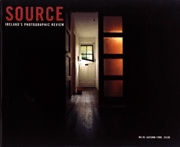Belfast Degree Shows
Review by Mary Cosgrove
Issue 20 Autumn 1999
View Contents ▸
If cultural models are to be appropriate to our situation they must involve spatial issues. Despite or because of sectarian boundaries, Belfast is a prime example of an alienated city where people are unable to map their positions in their minds. Alienation is further evident in the Ulster University's art department building. Brutally situated between Stevenson's warehouse and the Co-operative Store as part of the academic institutionalisation of the modern movement, it has no orientation. Art students must chart their separate and largely unassisted routes through building sickness towards a reinvented history. The remapping of cognitive space is evident in the co-ordinates of the photographic content of the Degree Show and briefly helps alleviate the alienation of city and building. David Keith - Pro Patria - Installation shot
David Keith - Pro Patria - Installation shot
The existential fragmentation of the city and college that follows alienation is documented by Matthew Thompson who concentrates on technical innovation. Nicola Jackson and Nick Patterson take a sociological path and use fine studio portraits to chart lines of experience. David Keith's lightboxes, on display beneath the Dunkirk plaque in the nearby Cathedral, contain landscapes of World War battles. The choice of sites increases the power of his statement about the futility of war and makes clear that his intention is not just to create another partisan memorial. Keith also uses commercial billboards outside the college to display his work. The black and white photograph of the Vimy monument to commemorate sixty six thousand Canadians killed in World War One has an air of unreality. Placed alongside the coloured photograph of countryside of the Somme it has the silence of the sublime. Without explanatory text or clues it over relies on the public's ability to forge a signifying link with its anti-war statement. David Keith - Pro Patria
David Keith - Pro Patria
William Gary Armstrong leaves viewers to define their relationship to extremes of local conditions by exhibiting the reality of statistics against romantic scenes of decay. Set in the Old Museum, his photos replay the original specimens of the Belfast History Society as relics of a disappearing era of structured opposites. Satisfyingly, Armstrong's work helps to reclaim the Museum's role as scientific chronicler of the city's history while simultaneously reminding us that the College of Art was once housed in the neighbouring College of Technology which disrupted the classical symmetry of College Square. Martina Corry - Photogenic Drawings
Martina Corry - Photogenic Drawings
Martina Corry's work is not so much a stylistic recuperation of High Modernism as a pretence that the object of desire was never lost. Her photogenic drawings on display in a prison-like college cell have no object and involve no camera or negative. The aesthetic experiment produces decorative results with a corresponding lack of relationships. Free floating and impersonal like a pastiche of abstract painting, their pseudo-historical links to Fox Talbot show no trace or ironic knowledge of the historical battle behind the ratification of this genre. The ideological implications and ramifications of this work being awarded the only distinction in the MA group are clear especially when viewed against the work of Olywn Montgomery, another MA student. Martina Corry - Photogenic Drawings
Martina Corry - Photogenic Drawings
Montgomery appropriates fragments of her specific context to create a critical text that recognises the political agendas of art institutions. The bricollage of raw materials of her life that includes photographs of members of staff inspecting her work is deliberately anti-aesthetic. She demystifies art and facilitates public access to the struggle for meaning in art production by grounding her work in local politics. The contrast between Corry's work and that of Montgomery is colossal and reveals a contest seldom seen at this level at the Belfast College of Art. Students' early attempts at overt political reference are discouraged and they soon learn to treat the appearance of a work as paramount. Montgomery attempts to produce radical forms with an intellectual life and challenges an art education system whose inflexible heuristic method leaves many casualties.
Montgomery's cartography and Corry's lodestar are markers of real and imaginary relationships to conditions of existence. Corry's work may well come to represent the spatial extension of the College with its renewed combination of piety and commerce into the regenerated Cathedral Quarter. Montgomery maps cognitively the social scale. Ideally a combination of the two is needed.
Other articles mentioning Martina Corry:
Other articles on photography from the 'Multi-Genre' category ▸






